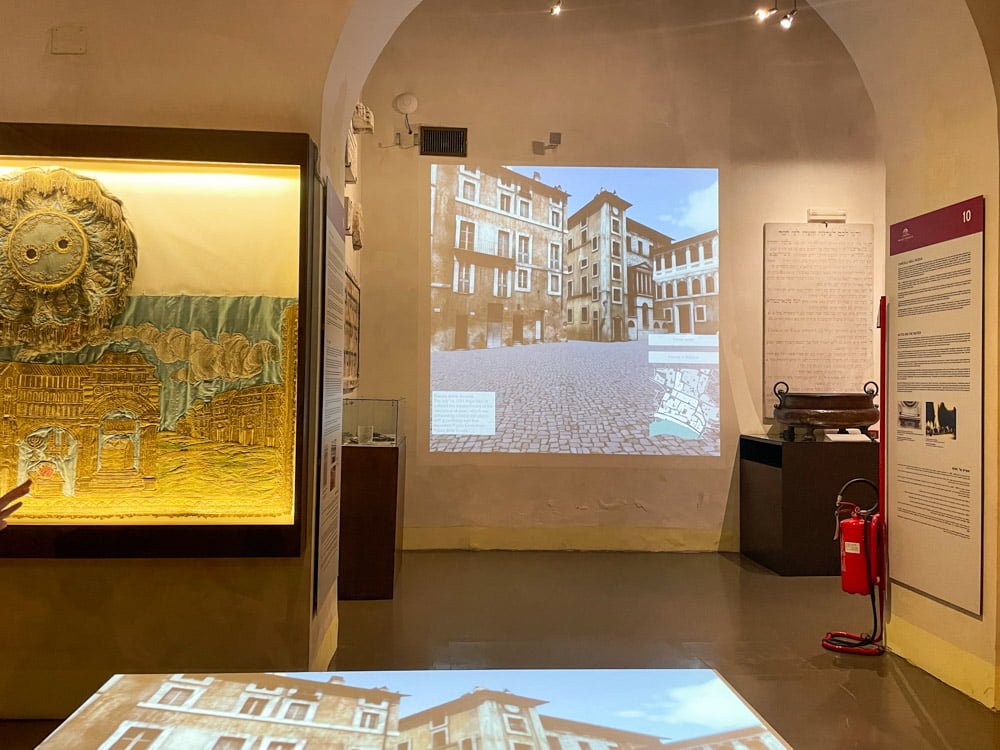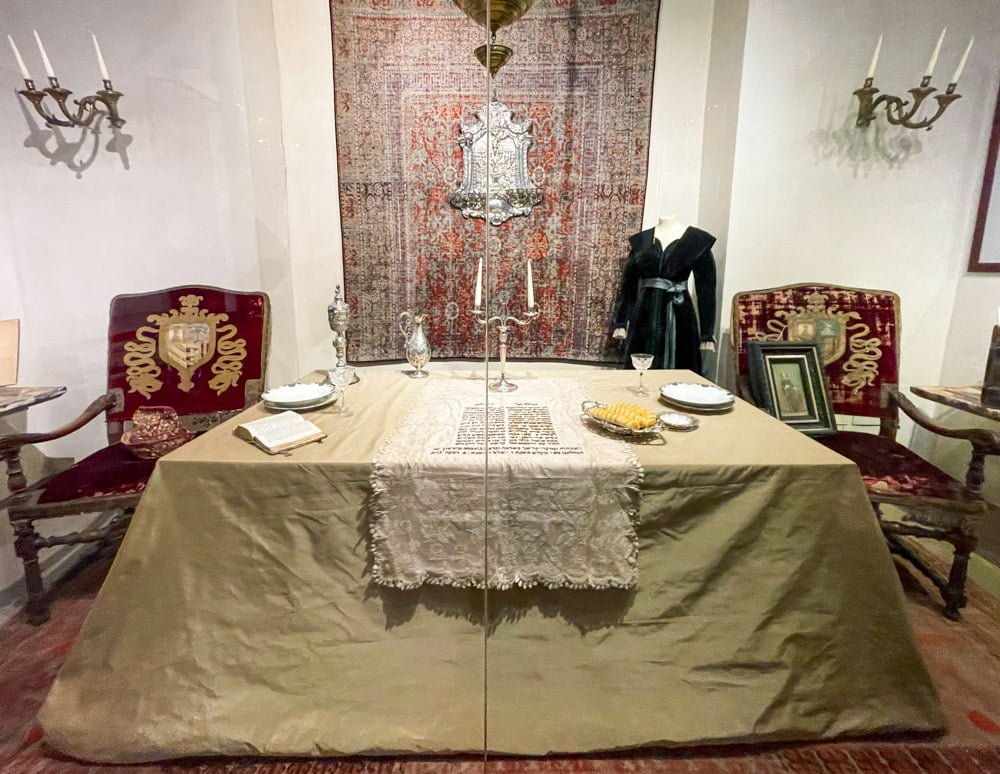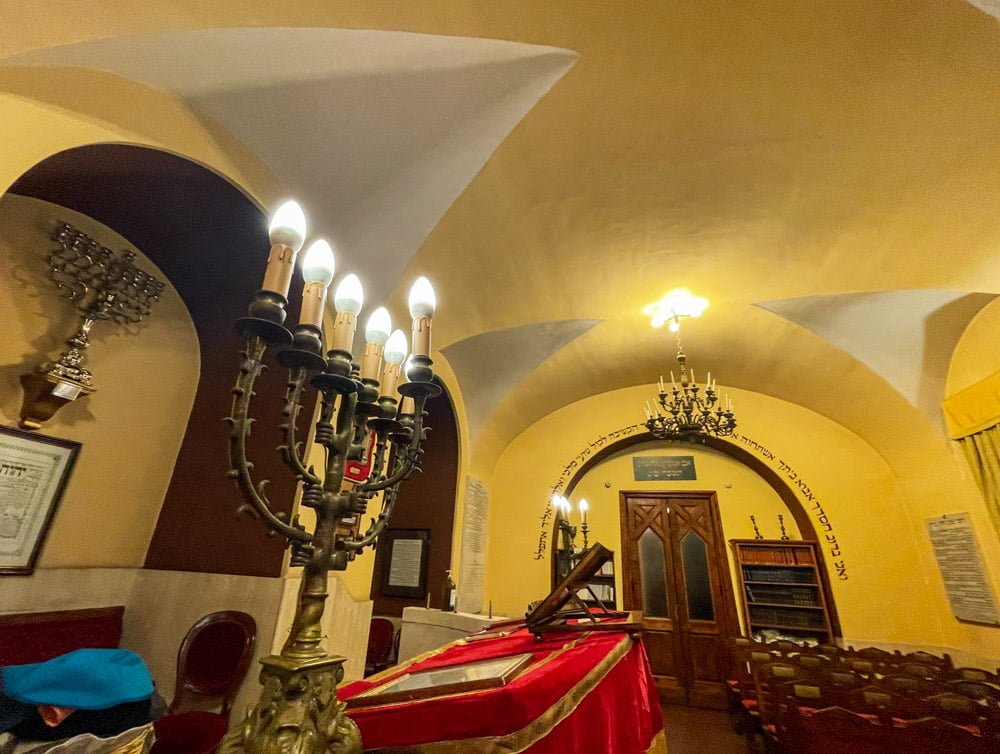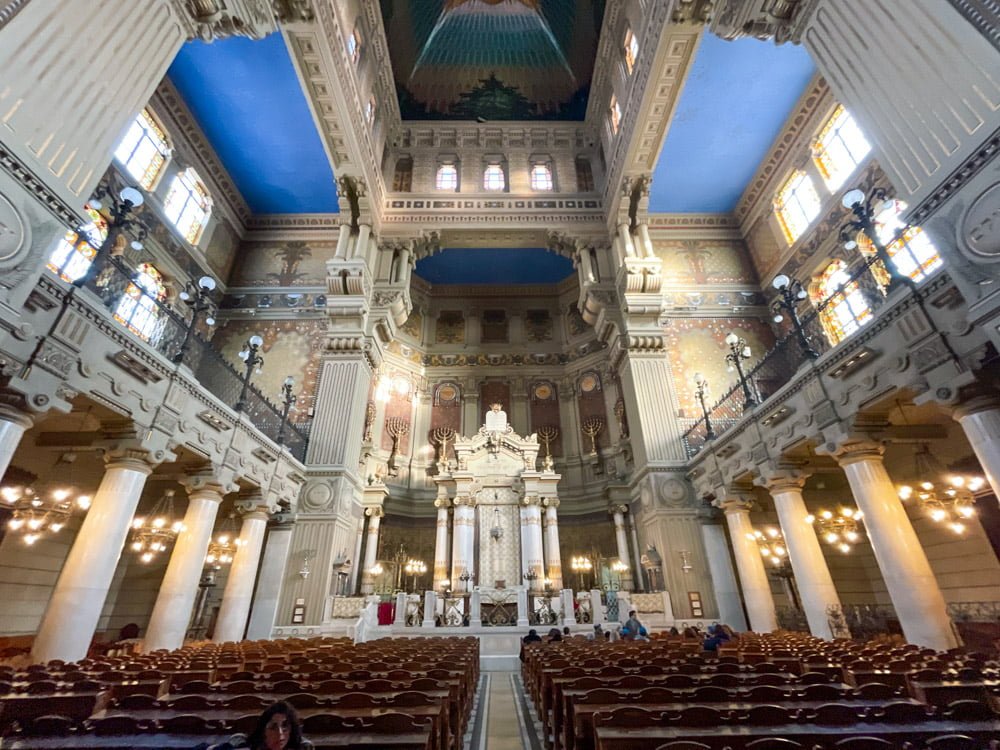In Rome, you can embark on a fascinating journey into the Jewish heritage, visiting the Jewish Museum and the Great Synagogue to gain insight into this unique and long-standing culture. The Jewish community has been a part of Rome for over 2200 years, making it one of the oldest in the world. The museum has several rooms that take you through the community’s history and relationship with political and institutional Italy. You can aslo visit the Great Synagogue, a monumental temple with stunning decorations.
Table of Contents
What to see in the Jewish Museum of Rome
The Jewish Museum of Rome is inside the monumental complex of the Great Synagogue, the capital’s largest synagogue. In addition to the temple, the building houses the offices of the Jewish community. The museum occupies the basement area, divided into several rooms, each with a different theme.
PLAN YOUR TRIP TO ROME
Save money on entrance fees and transportation costs with the Roma Pass. This City Card offers free entry to two attractions, as well as discounts at other museums and archaeological sites, including the Colosseum, the Roman and Imperial Forums, the Capitoline Museums, the Ara Pacis and other must-see.
To stay connected in Italy, remember to buy an Airalo eSim online, with data and phone coverage for your trip to Rome.
The leitmotif of the exhibition is the life of the Jewish population in Rome. From the first settlements to the Nazi deportations, with a focus on the changes brought about by the Unification of Italy.
In general, life for Italian Jews was never easy. The preaching of the mendicant Franciscan and Dominican friars constantly threatened the presence of Jewish communities. The life of Roman Jews alternate phases of peaceful or tolerated coexistence. The community, one of the oldest Jewish communities in the world, settled in the main centre of Christianity.
In the Jewish Museum, you can discover the period of overcrowding under the Papal States in the Ghetto, the Italian name for the Jewish Quarter. In contrast, there was a positive integration after the annexation of the Papal States to Italy, which guaranteed Jews the same rights as other citizens.

How the Jewish community developed in the Ghetto of Rome
Rome’s Jewish community is one of the oldest outside Israel, so the Roman Ghetto is one of the oldest in Europe. The Jewish Quarter in Rome was established forty years after Venice, the first ghetto ever. In the Jewish Museum, you can discover how Pope Paul IV in 1555 created the Ghetto to delimit the area where Roman Jews could reside and revoked their civil rights at the same time.
Life in the Ghetto of Rome
Pope Paul IV installed the Ghetto in this area because most Roman Jews already lived in Trastevere and the Aventine area. Trastevere, in particular, housed the Jews expelled from Spain after the Edict of Granada, issued by the Catholic kings Isabella of Castile and Ferdinand II of Aragon.
Segregation forced Roman Jews to reside within the Ghetto, which was closed at sunset and reopened at dawn. Also, they were prohibited from trading apart from rags and second-hand clothes. Because of this imposition, some of the objects on display in the museum are richly embroidered textiles used to protect the scrolls of the Torah, the Hebrew Bible.
Jews from Libya
While visiting the Jewish Museum in Rome, I discovered that the city’s Jewish community includes many people from Libya. During the colonial period, Italy occupied Libya, and this created the first link between Libyan Jews and the Roman community.
However, the reason why there was a substantial migration to Italy was due to the 1967 Six-Day War and the persecution of the Jewish communities in Libya. The fleeing Jews moved mainly to Israel and Italy, particularly to Rome.
Today, the Libyan Jewish community is integrated with the original Roman one but keeps its traditions alive. For example, the difference in religious rites has led to the establishment of Sephardic synagogues. Still, there has also been a positive contamination of Middle Eastern cuisine into Jewish-Roman cuisine.
Jewish culture and everyday family objects
The Jewish Museum of Rome collects and exhibits objects donated by Roman Jewish families that tell the story of Judaism in everyday life. Here, you can see a table set for Shabbat (שַׁבָּת), the Sabbath meal, according to tradition. Another interesting object is the mezuzà, in Hebrew מזוזה, the small case containing a sacred text placed on the front door of Jewish houses.
There are also some Chanukkah, the seven-armed Hebrew candelabrum for home worship, sometimes called Menorah. Chanukkah name comes from the Hebrew חֲנֻכָּה and, as many sounds of Hebrew do not exist in European languages, you can see different translations such Hanukkah, Ḥanukka or Chanukah.
The objects on display in the Jewish Museum represent aspects of Jewish culture experienced first and foremost in the family. I had previously seen many of these objects in homes in Israel, and they brought back memories of that wonderful trip.

Worship objects of the Roman Jewish community
During a visit to the Jewish Museum of Rome, you can discover many interesting facts and information about the Jewish religion. For example, about the sacred value of religious books or the fact that you cannot depict or write the name of God.
The Sefer Torah (in Hebrew spelt as תּוֹרָה) is a scroll with the part of the Old Testament called the Pentateuch written by hand. It is the most important object in the synagogue. For this reason, in the Museum you can see only a smaller-scale reproduction.
On the other hand, you can see a lot of meil (or me’il, in Hebrew מְעִיל), richly decorated textiles used to hold the Torah scrolls. There are also several yad, usually translated as index, but meaning “hand” (יָד), the tools used to hold the reading sign without touching the scroll.
The Synagogues of the Five Schools
Inside the Jewish Museum is a small synagogue of Spanish worship, built in the 1930s and furnished with objects from the Cinque Scole (five school), the ancient Roman synagogues of the Ghetto, now demolished. There were five synagogues in Rome according to different rites, but eventually, they were all moved to the same building. Under the papacy, in fact, Jews were allowed to have only one place of worship in the entire city.

The relationship between Rome’s Jewish community and Italy
Part of the Jewish Museum explains the relationship between the Italian Jewish community, particularly the Roman one, and Italy. The Roman Jewish community was firmly attached to Italy, more to the other Jewish communities scattered around the world.
At a time when nationalism had ignited Europe, Roman Jews participated enthusiastically in the First World War, earning medals for bravery. The bond with Rome was firm, and when the racial laws came into force, and the notorious blackmail of Rome’s gold took place, many Christians also contributed to the collection of gold to save the Jews.
At the Jewish Museum, you can also discover the history of Rome’s Ghetto. From being an unhealthy and overcrowded district under the papacy to its current form, given by the new city plan after the Unification of Italy. This event granted new rights, including the possibility of erecting a monumental synagogue, today’s Great Synagogue.
Since the building of the Ghetto, ordered by Pope Paul IV, the Jews had no longer enjoyed civil and political rights. This, until the annexation of Rome to the Kingdom of Italy, when the Statuto Albertino came into force automatically. With the annexation of Rome to the Kingdom of Italy, the temporal power of the popes came to an end. The Ghetto rules were then abolished, and the Jews were finally put on an equal footing with Italian citizens.
Great Synagogue: the capital’s monumental synagogue
The Great Synagogue is Rome’s main synagogue and one of the largest synagogues in Europe. Its construction replaced the previous Five Schools synagogues. Inaugurated in 1904, the Great Synagogue features a square-based dome, the only one in Rome with this feature. The style of the synagogue is eclectic, with the fusion of Greek and Egyptian elements adapted to the architectural context of Rome.
Although at first glance it may look like a large church, there are no paintings or pictures on the walls of the Great Synagogue. According to the Jewish religion, painting of God would be an act of idolatry. The large balconies at the top accommodate women during religious services because they pray separately from men.
The synagogue’s interior has a unique layout. The Aron, the cupboard facing Jerusalem for the Torah scrolls, is behind the pulpit instead of in the position envisaged by the tradition of the Roman rite. You can discover these details during the guided tour of the Great Synagogue, which is part of the visit to the Jewish Museum of Rome.

Practical information for visiting the Great Synagogue and the Jewish Museum of Rome
The museum is focused on Jewish traditions and the history of the Roman Jewish community. It is suitable for children because just a small part of the exhibit is about Nazi deportations. There are interactive stations and QR codes for more in-depth information.
To learn more about the life of the Jewish community, you can book a guided tour of the Ghetto of Rome. The guided tour of the Great Synagogue is always included in the entrance fee.
How much tickets for the Synagogue and the Jewish Museum cost
Museum entrance tickets cost €11 and include an audio guide downloadable to your smartphone. Remember to bring headphones to avoid disturbing other visitors. Discounts are available for students, Roma Pass holders and subscribers to some of the capital’s museums. Children up to 10 years of age get in free.
You can buy tickets directly on-site or on the Jewish Museum of Rome website.
How to get to the Great Synagogue and the Jewish Museum of Rome
The Jewish Museum is under the Great Synagogue, Rome’s main synagogue, in the Ghetto neighbourhood. It is close to Tiber Island and the Trastevere district. The nearest metro stop being Circo Massimo, which is about one kilometre away.
The area is very central so you can easily reach it on foot. If you have to use public transport, I recommend the metro. The traffic in Rome can be chaotic. By bus you’ll spend about the same amount of time than on foot.
Museo Ebraico di Roma (Jewish Museum of Rome)
Via Catalana
00186 Roma
Where to stay in Rome
I have tried several hotels in Rome during my travels and I recommend staying in the city centre to avoid the chaotic traffic of the capital. Among the hotels I suggest, the charming Roma Suites Navona has family rooms and is in a great location just a few steps from Piazza Navona.
If you prefer a hotel with a buffet breakfast, you can choose the Bloom Hotel Rome, very close to St Peter’s Basilica, while if you arrive by train, the best choice near Termini station is the DoubleTree By Hilton Rome Monti hotel with double and family rooms.
Share in the comments if you already know the Jewish Museum of Rome and the Great Synagogue. Or if you decided to visit them after reading my article. I definitely recommend to visit them because you can discover a lot about Rome’s Jewish community, an important part of the city of Rome.
